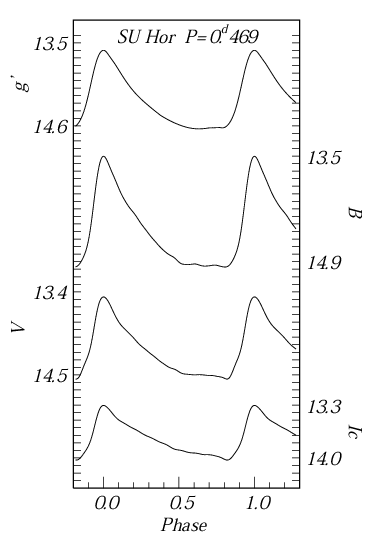|
Peremennye Zvezdy (Variable Stars) 40, No. 9, 2020 Received 17 November; accepted 25 November. |
Article in PDF |
|
DOI: 10.24411/2221-0474-2020-10010
|
BVIc CCD Observations of RR Lyrae variable SU Hor
L.N. Berdnikov1, A.Yu. Kniazev1,2,3, A.K. Dambis1, V.V. Kravtsov1
- Sternberg Astronomical Institute, Lomonosov Moscow State
University, Universitetskij pr. 13, Moscow 119992, Russia
- South African Astronomical Observatory, P.O. Box 9,
Observatory, Cape Town, 7935 South Africa
- Southern African Large Telescope Foundation, P.O. Box 9, Observatory, Cape Town, 7935 South Africa
|
We present 3965 magnitude measurements in the |
1. Introduction
In 2009, we started a program aimed at obtaining photometric observations for RR Lyrae variables that had no reliable light curves. The first results of our photometry were published by Berdnikov et al. (2012) who suspected the presence of Blazhko effect (Blazhko, 1907) for several stars, including SU Hor.
To study the Blazhko effect, we continued to observe SU Hor. Here we present the results of our photometry.
2. Observational data
We performed new CCD observations of SU Hor in 2012-2014 (in the
JD 2455896-2456679 range) with the 76-cm telescope of the South
African Astronomical Observatory (SAAO) using a SBIG CCD ST-10XME
camera equipped with ![]() -band filters of the Kron-Cousins
photometric system (Cousins, 1976). A description of the observing
data reduction technique can be found in our previous paper
(Berdnikov, 2012). We acquired a total of 2900 CCD frames, where
extracted magnitudes of SU Hor had errors close to 0.01 mag.
-band filters of the Kron-Cousins
photometric system (Cousins, 1976). A description of the observing
data reduction technique can be found in our previous paper
(Berdnikov, 2012). We acquired a total of 2900 CCD frames, where
extracted magnitudes of SU Hor had errors close to 0.01 mag.
We also used the Las Cumbres Observatory Global Telescope (LCOGT)
Network (Brown et al., 2013) to acquire 1065 CCD ![]() frames
during the time interval JD 2456633-2456689. We reduce LCOGT
observations by performing differential photometry relative to
secondary standards whose magnitudes we determined based on
observations made in SAAO; the photometric errors of these
observations are close to 0.02 mag.
frames
during the time interval JD 2456633-2456689. We reduce LCOGT
observations by performing differential photometry relative to
secondary standards whose magnitudes we determined based on
observations made in SAAO; the photometric errors of these
observations are close to 0.02 mag.
All observations are available in a text file in the html version of the paper.
The light curves are shown in Fig. 1, where the big scatter of points supports the presence of Blazhko effect. We plan to use our data to search for the Blazhko effect period.
On the base of our observations we constructed the ![]() -,
-, ![]() -, and
-, and
![]() -band template curves, presented in a text file in the html
version of the paper and Fig. 2; together with them, we present
the
-band template curves, presented in a text file in the html
version of the paper and Fig. 2; together with them, we present
the ![]() -band template curve, based on observations from the
ASAS-SN catalog (Jayasinghe et al., 2019). Table 2 lists the
-band template curve, based on observations from the
ASAS-SN catalog (Jayasinghe et al., 2019). Table 2 lists the
![]() -,
-, ![]() -,
-, ![]() -, and
-, and ![]() -band magnitudes of SU Hor at phases
from 0 to 0.995 with a step of 0.005.
-band magnitudes of SU Hor at phases
from 0 to 0.995 with a step of 0.005.
We plan to use these templates to study the behavior of pulsating period of SU Hor.
Acknowledgments: This work was supported by the Russian
Foundation for Basic Research (project nos. 18-02-00890 and
19-02-00611).
References:
Berdnikov, L.N., Vozyakova, O.V., Kniazev, A.Yu., et al. 2012, Astron. Rep., 56, 290
Blazhko, S. 1907, Astron. Nachr., 175, 325
Brown, T.M., Baliber, N., Bianco, F.B., et al. 2013, Publ. Astron. Soc. Pacif., 125, 1031
Cousins, A.W.J. 1976, Mem. RAS, 81, 25
Jayasinghe, T., Stanek, K.Z., Kochanek, C.S., et al. 2019, Mon. Not. Roy. Astron. Soc., 485, 961

